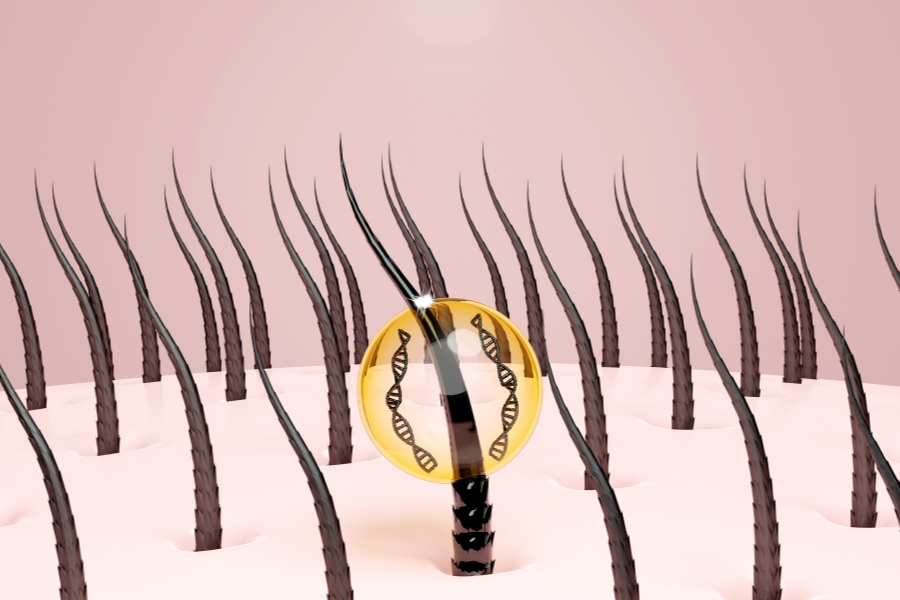Decoding the Hair Growth Cycle and Understanding How We Shed: An Overview of Anagen, Catagen, and Telogen Phases

In nature, it is easy to observe growing seasons. There is a time when plants are thriving and blooming, but eventually, they die back. Some shed their leaves to conserve energy as they head into the colder months, and others die off completely with hopes you reserved some seeds for future planting. The hair on our heads, much like nature surrounding us, also has a growing season. But each hair fiber lives its journey and experiences growth and death independent of its surrounding hair fibers. As a result, our hair-growing seasons are much harder to observe. So let’s talk about what a healthy life cycle for hair looks like.
Our hair goes through three phases of growth in its lifetime: the anagen phase, the catagen phase, and the telogen phase:
The anagen phase is essentially our “growing season,” and roughly 80% of the hair on our heads is currently in this growth phase. This phase can last between 3-7 years for a healthy individual and is primarily determined by genetics, hormones, age, and diet. Some medications can negatively affect the anagen phase by pushing hair into the catagen phase prematurely, but a healthy diet and active lifestyle can help prolong this phase.
In the catagen phase of hair growth, the hair follicle is in transition. Hair growth slows down as the hair follicle shrinks. This phase culminates with the hair detaching from the follicle. With the hair fiber no longer connected to its blood supply, growth comes to a halt, but the hair fiber stays connected to the scalp.
During the telogen phase, hair lies dormant for a few weeks to months. The telogen phase is the final stage of the hair growth cycle, also known as the "resting phase" of hair growth. During this phase, the hair prepares to peace out and shed from the scalp.
Hair shedding during the telogen phase is a natural part of the hair growth cycle and should not be a cause for concern unless it is excessive. Between 10-15% of hair follicles are in the telogen phase at any given time, so shedding 100 fibers each day is perfectly normal.
During the final stage of the telogen phase, the follicle becomes active again and releases the hair fiber completely to prepare for the growth of a new one. This is the phase when hair ends up on clothing, furniture, combs, and brushes. (Also known as the exogen phase).
So what happens when too much hair falls all at once?
Temporary hair loss can occur due to various reasons, such as stress, hormonal changes, nutritional deficiencies, or medical treatments like chemotherapy. The recovery time for hair growth after temporary hair loss can vary depending on the underlying cause and individual factors, but generally, it takes about 3 to 6 months for the hair to start growing back after temporary hair loss. However, it can sometimes take up to 12 months or longer. The new hair growth may be thinner or different in texture, but it may gradually return to its previous thickness and texture over time.
What are some natural ways to prevent hair loss without surgery or prescription medication?
While some cases may call for medical intervention at the discretion of your dermatologist or trichologist, it is possible to help prevent temporary hair loss through an active lifestyle, adequate hydration, a healthy gut, and a nutrient-dense diet. Balancing mental stress with activities that spark joy also helps improve overall wellness and prevent premature shedding. If you experience a temporary period of excess hair fall, a healthy lifestyle will help reduce the time it usually takes for the follicle to produce new hair.
So what’s the takeaway?
Most of the hair fibers on your head are in their growing season, and the Nu Standard of hair wellness is to nourish that hair as much as possible throughout this time to optimize growth. If you love the versatility of regularly styling your hair, we highly recommend contacting your stylist about our hydrating reconstructive treatments. And as always, be kind to your hair with our daily maintenance products that provide the ultimate protection and care.



